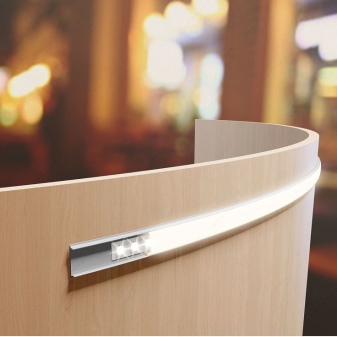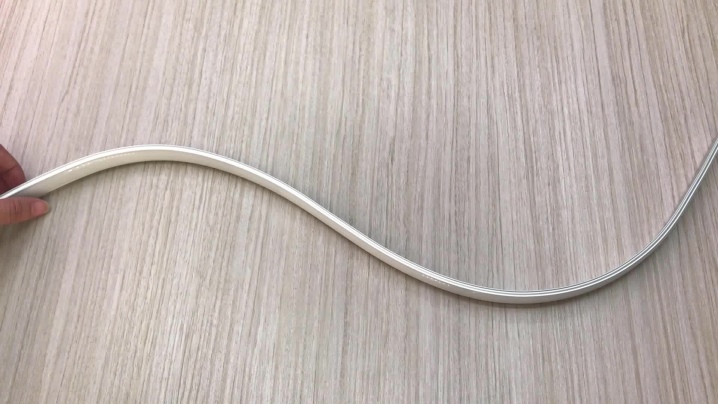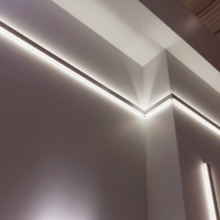Features of flexible profiles for LED strips

The features of flexible profiles for LED strips must be studied in advance, even before purchasing them. Correct use of aluminum bending profiles for diode strips greatly simplifies their operation and increases overall reliability. Along with the description of the profiles themselves, it is necessary to take into account the specifics of the installation work.


Description
The aluminum flexible profile for LED strip works very well in the design of a semicircular corner. It is also encouraged to use it for arches. You can easily prepare lamps of the most original type. For the manufacture of such structures, anodized aluminum is taken, which is characterized by increased strength.
Therefore, you can not doubt the perfection of the external appearance.


In addition, the anodized profile is perfectly protected from:
- small chips;
- scratching;
- accumulation of dirt and dust.

With the help of such a product, you can easily form the backlight that meets the highest aesthetic requirements and visually refine the structure. It is easy to install the profile element even in difficult places where other decoration devices are hardly acceptable. Aluminum has an impressive thermal conductivity. As a result, it helps to remove heat from the tape and exclude an unreasonably early decrease in its brightness. The service life of the luminaires will be significantly extended.

Since aluminum is usually used in the manufacture of profiles, such a solution clearly cannot be cheap. Therefore, any qualified craftsman, and even the customer, always strives to save on such a product. The average rating of thermal conductivity ranges from 0.01 to 0.15 kW per 1 m.
Attention: this index must be higher than that of LED units. Only under this condition is the reliable functioning of the finished assembly guaranteed.


In some cases, along with aluminum, plastic is used to obtain a profile. Then it is necessary to evaluate the thermal characteristics even more carefully. Corner (and not only) profile models are mainly equipped with removable diffusers. This reduces the excessive brightness of the LEDs that can harm people's eyesight. Modern diffusers reduce the luminous flux by an average of 75%.

The built-in type of profiles is designed to help in organizing design solutions if you want to create a unique interior. You can use it to join chipboard and drywall, placing the tape exactly at the intersection. The modules can be located both above the surface planes, and according to the flush principle. The edge is made so that all emerging irregularities overlap. Embedded profiles are in demand in kitchen and dining areas; Many decorators try to put LEDs inside the furniture so that light flows out of it.



The cover profile is suitable for installation on all imaginable surfaces. For this purpose, both self-tapping screws and glue are used. Plastic overlay blocks help if the surface topography is especially difficult - because they are easy to bend in the desired way. For reasons of economy, where aesthetics are not too important, steel or aluminum profiles are used. Important: such building elements should not be perforated, corrugation is also unacceptable.


Applications
There are a lot of possibilities to use a bending profile for a diode radiating tape. Among the main options is the illumination of interior elements:
- the most advantageous parts of the floor or ceiling;
- stairs and separate handrails on them;
- steps on the stairs and on the porch;
- decorative furniture;
- surfaces in the kitchen, bedroom, hallway;
- arched structures;
- internal and external niches;
- books and crockery shelves.



But on this the spheres of possible use of the profile for the LED strip are not limited to. You can also take it to highlight:
- jewelry and similar decorative items;
- billboards, pillars and posters;
- exhibition and trade showcases;
- theater and club scenes;
- halls;
- hotel rooms;
- administrative buildings;
- offices;
- cafes, restaurants and many other facilities.

Installation tips
Before bending the profile, it should be slightly warmed up. An ordinary industrial hair dryer can help in this matter. As the heat increases, the flexion angle will increase. However, it should not exceed 90 degrees, even at the highest possible temperature. The installation procedure itself is quick and easy, no special knowledge and professional training is required.

Therefore, you can save on hiring professional builders. The use of the most common tools is allowed. Some companies supply profiles with specific fasteners, which additionally speeds up installation several times. They always work like this:
- fix the profile;
- mount the tape;
- a set of auxiliary equipment is being prepared for work;
- cover the tape with a scattering unit.

You can see how to install LED strips in the next video.













The comment was sent successfully.